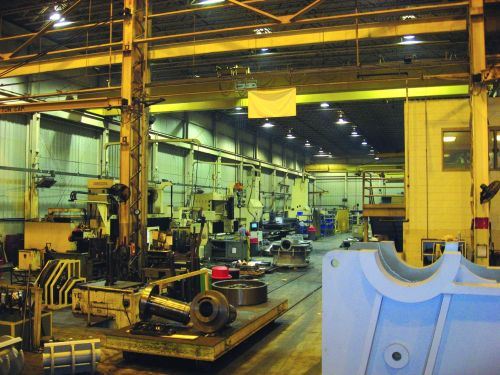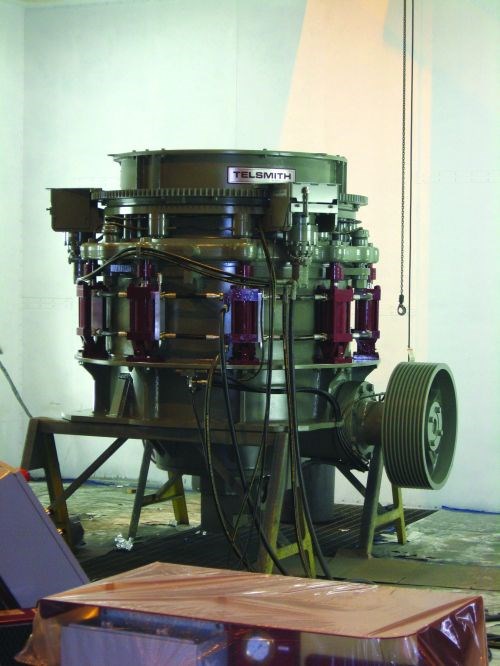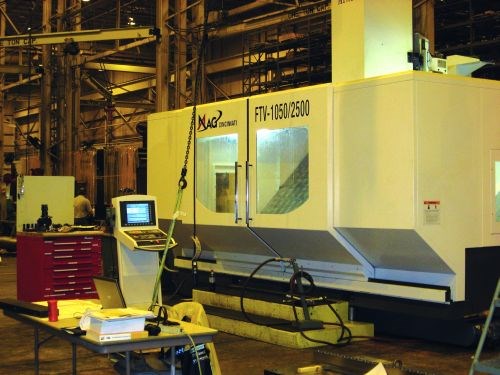Shop Aims For G Code
When rising material prices and the weak U.S. dollar contributed to a surge in demand from the mining industry, this manufacturer of rock-crushing equipment knew it had to boost productivity to keep up. Along with extensive support from trusted suppliers and an investment in new machines and cutting tools, the shop pushed the limits of its long-time CAM system to stay ahead of the curve.
Share






Hwacheon Machinery America, Inc.
Featured Content
View More



Some manufacturing technology success stories involve swapping out old vendors for new ones. That’s not the case at Telsmith, a manufacturer of rock-crushing machinery in Mequon, Wisconsin. The company recently implemented a stringent productivity program to keep up with skyrocketing demand from the mining industry resulting from rising metal
prices and a weak U.S. dollar. Rather than implementing solutions from new suppliers, however, the goal was to extract every bit of value from the shop’s CAM software and machine tools, both old and new, via extensive support from its trusted vendors.
Key to the shop’s success was a new programming method using Edgecam software from Planit Solutions in Southfield, Michigan. While the company had relied on Edgecam for more than 10 years, its efforts to increase productivity required pushing the program like never before. With the mantra "100 percent from the post," the company implemented a system in which each program addresses everything for every job in the postprocessor. In other words, it made part-program editing by overly cautious machinists a thing of the past, as such "tweaks" tended to increase cycle and delivery times. The result was significant cycle time reductions, increased feeds and speeds, doubled annual shipments and improved return on investment (ROI).
The company says these improvements would have never been realized without close cooperation with its vendors: Edgecam, machine tool builder Giddings & Lewis (a division of MAG Industrial Automation Systems, which has
been Telsmith’s exclusive supplier for 30 years) and cutting tool supplier Kennametal. As part of its efforts, Telsmith insisted that every productivity boost promised by its vendors be tracked through to ROI. Responsibility for making sure the company got its money’s worth rested with Dennis Van Asten, manager of manufacturing engineering, CNC programmers Michael Wier and David Worzalla, and the machine operators and supervisors.
Mr. Van Asten, Mr. Worzalla and Mr. Wier were given the go-ahead for long-overdue changes to the shop’s processes when rising demand for its rock-crushing equipment contributed to a $44 million backlog, the highest level in decades. The shop faced other difficulties as well. In mining, the business cycle is two to three times longer than other capital-intensive industries such as steel, automotive, aerospace or energy—and probably more erratic. Additionally, many of Telsmith’s ductile-iron castings weigh between 15 and 40 tons and cost thousands of dollars, and long delivery times make it difficult to replace scrapped parts. The company also must deal with competition from low-cost knockoffs.
"For just about any component, it’s just a few months before you start competing with your own designs," Mr. Wier says. The only solution, he adds, is "to keep innovating so the reverse-engineering copycats can never catch up."
The shop’s parent company, Astec Industries in Chattanooga, Tennessee, is the largest supplier of aggregate processing equipment in North America, and Telsmith is the cornerstone of that business. Telsmith makes three types of rock crushers (jaw, cone and impact) in several sizes for the mining, aggregates, quarrying, road-building and related industries, plus screens and feeders. The company operates around-the-clock in three eight-hour shifts plus a six-hour partial shift on Saturdays. All parts are made in-house except bevel gears
and commodity items such as bearings.
Mr. Wier and Mr. Worzalla were determined to make sure that the company delivered for Astec corporate as well as for customers. In addition to the heavy emphasis on 100-percent-from-the-post programming with Edgecam, the shop invested in high-grade carbide tooling from Kennametal and two new G&L machine tools, with a third budgeted for later this year. These are the shop’s first new machines in more than 10 years—until mid 2007, most work was done on eight 1980s-vintage G&L HBMs and VTLs. The new models are a four-axis vertical turning center, a three-axis Cincinnati VMC and a multi-axis turn/mill. All three are huge, measuring 20 to 30 feet high and nearly as wide.
To implement 100-percent-from-the-post machining, the shop had to accommodate extensive sets of macros for threading and probing. Done before almost every tool change and new cut, dozens of fully automated probing cycles in each part program help eliminate the risk of a tool crash. With a 30-second probe time, compared with 5 or 10 minutes previously, the shop now does much more probing. Probe data is automatically fed back to the postprocessor, eliminating another potential error risk and another set of tweaks.
Extensive probing justifies the shop’s purchase of high-end cutting tools from Kennametal, Mr. Wier says. The probing cycles can preempt the risk of damaging the tools on the cast workpieces’ rough surfaces, which often have an unpredictable amount of "flash," or extra stock.
In addition, the shop uses 42 pages of threading macros and variables, particularly for buttress threads. With their asymmetrical cross-sections, buttress threads are best to withstand the shock loads, vibration and high stresses in rock crushers. Unlike other machines, Mr. Wier says, the shop’s new vertical turning center (a G&L VTC 2500) can accommodate changes in feeds in speeds while buried in the cut without losing the lead angle. This allows the shop to change threading feeds and speeds using the various macros, even on the same thread, to shorten cycle time.
Programmers also use CAM program variables to simplify updates—and machining cycles can have as many as 17 different variables. "Developing the variables may take us longer initially, but any time we can simplify inputs at the machine and remove potential for error, we feel it’s time well spent," Mr. Wier says. Commonly used variables include cutter approach distances and retract positions, cutting depths and changing reference planes.
While more fully utilizing Edgecam’s capabilities has shortened production time, it has also extended programming time and led to long hours in the shop. In part, that is because 100-percent-from-the-post programming shifts much of the responsibility for parts from the machinist to the programmer. During the initial setup and runoff of the new machine tools, Mr. Wier and Mr. Worzalla coped with workdays running from 6 a.m. until1 a.m.
"We want the machinists to give us feedback on how the new programs run. We feel these extra efforts will make a good machinist twice as good," Mr. Wier says. "The best way to ensure a good return on any investment is increasing the knowledge of employees," Mr. Van Asten adds.
Mr. Wier is philosophical about the extensive time commitment. "The learning experience in a new program—and there always is some—should be in the programming and not out at the machine tool," he says. "If writing a new program takes an extra hour, that time is never wasted. The learning can be saved, reused and transferred. But extra machining time caused by a poorly thought-out program is wasted."
Regardless of the time spent implementing these improvements, the company is happy with the results. It has kept pace with the demand boom—shipments in the second half of 2007 equaled shipments for all of 2006. Using 100-percent-from-the-post programming to provide machinists with "bulletproof" G code has eliminated instances of jobs sitting idle, with spindles milling air during tweaks and edits. Also gone are overly cautious feeds and speeds, a big factor in Telsmith’s long machining cycles. In fact, feeds and speeds have increased as much as tenfold.
The most dramatic results of Telsmith’s multimillion-dollar investments in machining, programming and productivity have been cycle-time reductions on its older machine tools, which helped to double shipments and generate $500,000 in savings within the first few months. Jobs done on the new machines have averaged 60- to 80-percent shorter cycle times. "Jobs that took a week before are now done in a day and sometimes in four hours," Mr. Van Asten says.
Another significant achievement is financial—cutting the anticipated ROI on the first two new machine tools to about 18 months. The original projection had been for as long as six years, or roughly four times slower. This is an
all-in calculation, Mr. Wier explains, not just the machines’ purchase prices. It includes building foundations, runoffs at G&L, training, tooling
and more.
Big customers also took note of the shop’s improvement efforts. "This has been a huge success for us, and the word is getting out," Mr. Van Asten says. "We had representatives from Caterpillar here when we ran off the G&L, and they were amazed at what we were able to do."
Mr. Wier credits Telsmith’s success to the three most important factors in a technology decision: "support, support, support." "Telsmith productivity gains were achieved because we and Edgecam and G&L all worked together very closely," Mr. Worzalla says. "With MFGtech (an Edgecam reseller in Rockford, Illinois), Edgecam has excellent support. They catered to our needs more than the competitors, and the training classes were very thorough."
One reason the relationship with G&L and Edgecam worked out so well was the "total lack of finger pointing," he adds. "The attitude was always: ‘let’s get it done!’"
Related Content
How to Mitigate Chatter to Boost Machining Rates
There are usually better solutions to chatter than just reducing the feed rate. Through vibration analysis, the chatter problem can be solved, enabling much higher metal removal rates, better quality and longer tool life.
Read More4 Commonly Misapplied CNC Features
Misapplication of these important CNC features will result in wasted time, wasted or duplicated effort and/or wasted material.
Read MoreCan ChatGPT Create Usable G-Code Programs?
Since its debut in late 2022, ChatGPT has been used in many situations, from writing stories to writing code, including G-code. But is it useful to shops? We asked a CAM expert for his thoughts.
Read MoreGenerating a Digital Twin in the CNC
New control technology captures critical data about a machining process and uses it to create a 3D graphical representation of the finished workpiece. This new type of digital twin helps relate machining results to machine performance, leading to better decisions on the shop floor.
Read MoreRead Next
Registration Now Open for the Precision Machining Technology Show (PMTS) 2025
The precision machining industry’s premier event returns to Cleveland, OH, April 1-3.
Read More5 Rules of Thumb for Buying CNC Machine Tools
Use these tips to carefully plan your machine tool purchases and to avoid regretting your decision later.
Read MoreSetting Up the Building Blocks for a Digital Factory
Woodward Inc. spent over a year developing an API to connect machines to its digital factory. Caron Engineering’s MiConnect has cut most of this process while also granting the shop greater access to machine information.
Read More
































.jpg;maxWidth=300;quality=90)












